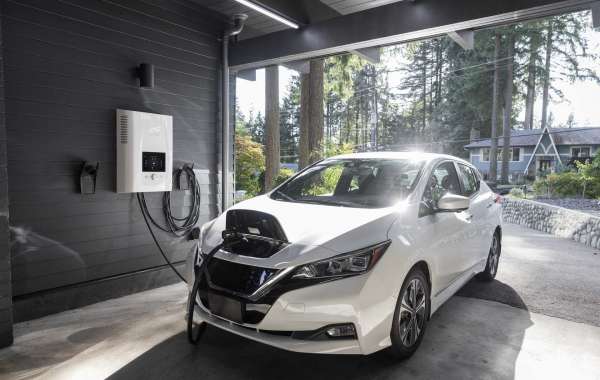The global Automotive Inverter Market was estimated to be at $8.3 billion in 2020, which is expected to grow with a CAGR of 17.09% and reach $50.1 billion by 2031. The growth in the global automotive inverter market is expected to be driven by increasing demand for electric vehicles to acquire sustainability and lower ownership costs.
Market Lifecycle Stage
The automotive inverter market is in the development phase. Increased research and development activities are underway to develop newer semiconductor materials such as gallium nitride, which are expected to witness an increase in adoption due to the lower energy and gate losses.
Increasing investments in RD in gallium nitride and silicon carbide is one of the major opportunities in the global automotive inverter market. Also, the exponential increase in the sales of electric vehicles across the globe will propel the market even further. Though there are some challenges in the market, such as lack of charging infrastructure and complex design requirements, the ongoing vital developments in the market are expected to overcome them in the forecast period.
Market Segmentation
- Segmentation 1: by Propulsion Type
o Battery Electric Vehicle (BEV)
o Plug-in Hybrid Electric Vehicle (PHEV)
o Hybrid Electric Vehice (HEV)
Automotive inverters for HEVs generated the most value in 2020 owing to a large number of HEV production in Asia-Pacific and Japan. Countries such as Japan rely on HEVs for their share in the electric vehicle industry and are one of the largest producers of HEVs through leading companies such as Mitsubishi, Nissan Motor Company, and Honda. However, the market will shift toward BEVs over the forecast period as BEVs number would increase exponentially in the coming years.
- Segmentation 2: by Vehicle Type
o Passenger
o Commercial
Passenger electric vehicles are expected to dominate the market throughout the forecast period. It can be attributed to the larger number of passenger vehicles when compared to commercial vehicles currently. However, it is to be noted that commercial vehicles use heavier automotive inverters owing to their larger size and complex functions, which will also grow at a faster rate over time as commercial electric vehicles are readily being introduced in the EV domain.
- Segmentation 3: by Technology
o IGBT
o MOSFET
The IGBT is a full-controlled switch with three terminals (gate, collector, and emitter). The gate/control signal is sent between the gate and emitter, and the drain and emitter are the switch terminals. Owing to the newer electric cars requiring more output capacity, IGBT-based vehicle inverters can resist high voltages. The need for electric cars, which require excellent power efficiency and quick switching capabilities, is expected to drive the IGBT industry. As a result, the IGBT-based automotive inverter market is expected to witness significant growth.
- Segmentation 4: by Material Type
o Silicon
o Silicon Carbide
o Gallium Nitride
Silicon carbide (SiC) technology has a number of advantages, the most important of which is its electrical resistance. It is feasible to achieve the same resistance as silicon-based technology while utilizing a lesser mass using this technology. As a result, smaller and more efficient components may be created. Owing to the fact that switching losses are decreased, higher frequencies may be achieved with fewer passive components.
- Segmentation 5: by Power Output
o 130 KW
o 130 KW
All-wheel-drive (AWD) automobiles and commercial trucks typically have a power output of 130 KW. Vehicles with power outputs more than or equal to 130 KW are made up of more than or equal to two motors with power outputs greater than or equal to 130 KW, depending on the vehicle's power requirements. Battery electric vehicles, such as passenger cars, pickup trucks, and buses, typically have a power output of 130 KW. Therefore, as the number of BEVs and commercial electric vehicles would increase exponentially in the forecast period, the demand for 130 KW inverters would also increase at a faster rate.
- Segmentation 6: by Region
o North America - U.S., Canada, and Mexico
o Europe - Italy, Germany, Nordic Countries, France, and Rest-of-Europe
o China
o U.K.
o Asia-Pacific and Japan - Japan, India, South Korea, and Rest-of-Asia-Pacific and Japan
o Rest-of-the-World
During the projection period, the Asia-Pacific region is expected to be the largest market for vehicle inverters, as it has emerged as a hub for car production. Consumers' increasing spending power has sparked a surge in demand for autos in the region. Automobile manufacturers and automotive component suppliers hold strong market potential due to cost benefits for OEMs, low automobile penetration levels, and rising vehicle production. Many large OEMs have either opened manufacturing units in the region or partnered with big local vehicle manufacturers, owing to the availability of cheap labor and low production costs.
Request Sample - https://bisresearch.com/requestsample?id=1284type=download
How Can This Report Add Value
Product/Innovation Strategy: The product segment helps the reader understand the different types of inverter materials and technologies available for deployment in electric vehicles. Moreover, the study provides the reader with a detailed understanding of the different inverters by propulsion (BEV, PHEV, and HEV), by vehicle type (passenger and commercial), by material type (silicon, silicon carbide, and gallium nitride), by power output (130 KW and 130 KW), and by technology (IGBT and MOSFET).
Growth/Marketing Strategy: The global automotive inverter market has seen major development by key players operating in the market, such as business expansion, partnership, collaboration, and joint venture. The most favored strategy for the companies has been partnerships and collaboration to strengthen their position in the automotive inverter market. For instance, in March 2020, Marelli Corporation announced a strategic partnership with Transphorm Inc. to enable Marelli to gain access to technologies for the production of electric vehicles, in specific power converters, chargers, and inverters.
Competitive Strategy: Key players in the global automotive inverter market analyzed and profiled in the study involve inverter manufacturers. Moreover, a detailed competitive benchmarking of the players operating in the global automotive inverter market has been done to help the reader understand how players stack against each other, presenting a clear market landscape. Additionally, comprehensive competitive strategies such as partnerships, agreements, and collaborations will aid the reader in understanding the untapped revenue pockets in the market.
Impact
The automobile industry has seen a significant technological shift in the previous decade, opening the path for widespread acceptance of electric transportation. Various countries are implementing measures such as fuel economy standards, deploying support infrastructure for alternative propulsion vehicles, and providing consumer incentives to help bridge the ownership cost gap between alternative energy vehicles and conventional vehicles in order to reduce carbon emissions and increase the adoption of alternative energy vehicles. With the fast adoption of battery electric cars, plug-in hybrid electric vehicles, and hybrid electric vehicles, demand for automotive inverters, which are an essential component of alternative energy vehicles, has risen dramatically in recent years.
Impact of COVID-19
The COVID-19 outbreak affected the whole economy across the world. The COVID-19 pandemic had a severe impact on the automotive industry. In this outbreak, some industries are doing well while others have been crushed. The sector witnessed a massive decline in manufacturing/processing and in terms of sales. Likewise, the automotive inverter market was affected due to the shutdown of manufacturing facilities, which resulted in manufacturing interruptions across the world.
BIS Research Offerings - https://bisresearch.com/our-offerings/subscriptions
You May Also Like -








